View current page
...more recent posts
| 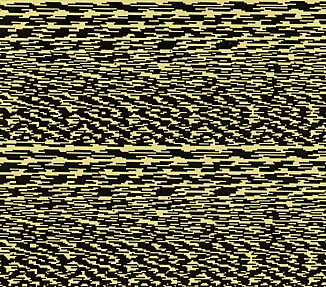 |
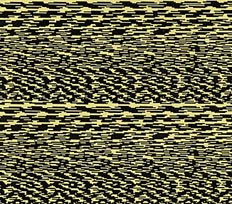 |  |
 |  |
| 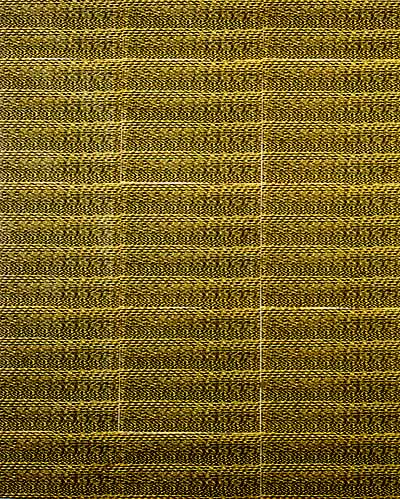 |
When I sent a drawing from the MSPaintbrush program on my computer to the network printer, the printer routinely sent back a message announcing that the job was finished. This caused a slight power surge, and I discovered that if I was sending another drawing to the printer at the exact same moment, the signals would cross and the second image would get "zapped," printing out as a uniquely garbled geometric pattern. I actually learned to time to the split-second when to send the drawing to get a good "scramble."
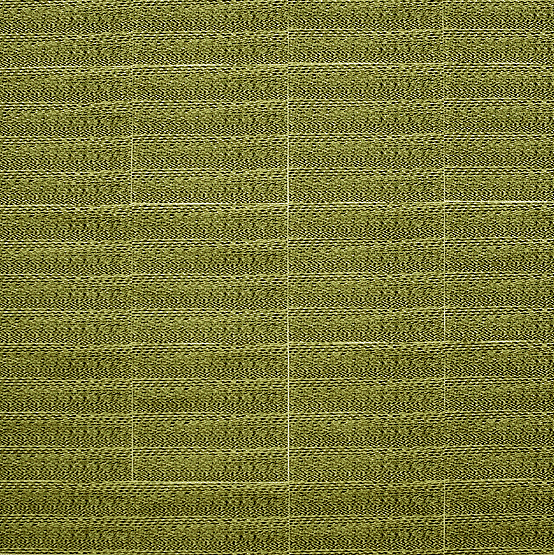
I made multiple photocopies of the scramble-pattern and joined them in a grid, applying linen tape to the back of the paper and then folding the paper around a painting stretcher and stapling it on the back. The result is a rather elegant, minimal quasi-painting born out of the drudgery of the modern office (during periods of official "down time," of course). The differences in color in these web pictures are just discrepancies among the scanner, slide, and digicam images used to make them.
I started thinking about this work again after the recent interview where jenghizkhan said "I started making music by scratching CD's [as in hiphop, turntable scratching] that I made from digital noise samples (similar to modem tones). I got the samples from saving the screwed up files that my computer sequencer would spew out when it crashed (which was all the time in the beginning). The scratching occurs sometimes at a super subtle and slow rate so that I can draw out all the tones that make up the white noise of digital streaming information."
That got me thinking about visual equivalents to those kinds of sounds, and the interest that exists across disciplinary lines in digital by-products, especially down at the "molecular level."
I purchased jenghizkhan's SidStation synth, as we discussed in our interview a few posts back, and got it hooked up a couple of nights ago. Here's a preliminary report. First, it remains to be seen whether this quote from Walker Evans, which I found on Bill Schwarz's page, will be relevant:
Time and again a man will stand before a hardware store window eyeing the tools arrayed behind the glass; his mouth will water; he will go in and hand over $2.65 for a perfectly beautiful special kind of polished wrench; and probably he will never, never use it for anything.The SidStation is a beautiful thing, in its simple and modest design, but I mean to use and not just drool over it. It's a bit like programming a cell phone, in that you punch arrow keys to move around within menus on the little green LCD screen. To make sound, you're supposed to control it with something. Most people would use a keyboard but I hate keyboards because I associate them with the past trauma of sixth grade piano lessons, so my goal is to use notes that I plug into a musical staff on my downloaded notation program (called Harmony Assistant, or HA).
Wednesday night I successfully got the SS hooked up to speakers and got the MIDI cables hooked up so my computer sends notes to the SS to play. Harmony Assistant appears to only send one MIDI channel to an outside instrument--I haven't figured out yet how to make it control more than one. I had hoped to be able to use the SS as a "lead instrument" in connection with HA rhythm and bass lines playing off the sound card in my computer, but with the SS hooked up to the speakers, I can't hear the other staves playing in HA. I'm going to try running lines out from both the computer and the SS to my mixer, so I can hear and record both sources.
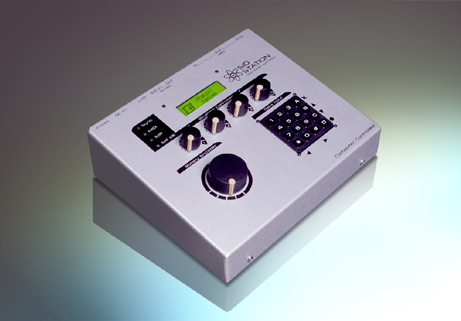
The SS is built around an actual, vintage Commodore sound chip from the '80s so it's limited in certain ways. It only produces sawtooth, square, and triangle waves--there are no smooth mellifluous sine tones, and everything sounds scratchy and buzzy and, well, like an old computer. jenghizkhan thoughtfully loaded the SS with preset "patches" from the SS website, which I haven't yet learned to modify, so I may still find a way to make a smooth sound. Some of the patches are single notes but most are loops of a handful of notes, so when you press an "A" note you hear a broken chord or prerecorded melody beginning with that note, "B" gets you the same sequence beginning with "B," etc. I want to start off working with single note melodies that I write (after first modifying the texture of the notes), so I already know there are lot of patches I won't be touching for a while. I clicked through all 90 or so patches and listened to them, using the real time editing knobs just below the green screen to alter them, and heard many cool sounds (and some obnoxious ones). I'm acclimated to my ancient Macintosh's array of lo-fi sounds so this still feels like an alien environment.
I just got some work photographed by Bill Orcutt, a pro who's taken my documentation shots for several years. Now I have transparencies made with a large format camera, with nice even lighting. After resizing for the web, they're still fuzzier than I'd like. A first stab is here, saved at approximately 270 KB. I may go a bit larger in the quest for more detail.
In a comment to a previous post Brian writes:
Interesting you would say, "That show was...critically successful...but the work isn't collector friendly because it's huge, aggressive and made of photocopy paper (precisely the things that make it appealing to critics). I've put a lot of thought and effort into resolving this contradiction." This sounds a bit like the tail wagging the dog, no? One of the things I've enjoyed about your work was that it always appears to be undeniably your work, operating in your sphere unaffected by the rumblings from without. Please tell me this is still the case.My reply: Yeah, I know it sounds like I'm selling out but the institutional frame (as in context) is important. Those big paper pieces appeared in a gallery and were seen because someone thought they could sell them. That's how the system works here in the USA. That validation process gives them an edge, which has always been in my work--a "good bad" painting doesn't really work its magic till you put it in the white cube. The physical framing of my current pieces does something similar: it says somebody thought enough of this computer-, home printer-made thing to plunk down the dough for museum-quality presentation of it. Now it looks like it's in the stream of commerce--something that could travel around to art fairs and be seen and discussed like the other stuff that travels around to art fairs and gets seen and discussed. I think it's better to acknowledge and confront the medium of exchange than adopt the pose of the heroic outsider. The work is just as subversive, trust me.
It's also not really selling out because of the second-tier status of paper. A painter friend said, "You've got to figure out a way to get this imagery printed on canvas, man. Then you could sell them!"
Claire Corey and I will be speaking at dorkbot-nyc ("people doing strange things with electricity") on Wednesday, November 3. Matt Hall and John Watkinson are also on the program. It's the day after election day and the mood is either going to be upbeat, or...well, you know. I'll be posting notes as the event approaches, but I like this phrasing of Claire's, describing her practice as a digital painter: "This hybrid medium questions both what is expected from works made with a computer as well as what constitutes painting." I've been thinking something along those lines in connection Jason Salavon's "100,000 Abstract Paintings," AKA Golem, where he wrote a software program that encoded parameters (size of brushstroke, color, etc) but also painterly qualities derived from studying the moves of Diebenkorn, Richter, and others. There is a dual critique there. What do we expect the computer to be able to do for us? Assemble cars? Play chess? Paint? Which tasks are necessarily "automatable" and which shouldn't be delegated? But also, what are attributes constituting "good painting" these days? If they're so quantifiable a machine can recreate them, are they really "good"? The critique is more obvious and pointed if you're talking about actually writing a program that does this (and I've seen Salavon's paintings and they're actually pretty "good") but it also applies to those of us just using the machine to make paintings: Claire, me, Millree Hughes... A curated show setting out these issues would be enormously helpful.
Gero von Randow made a mini-version of my "Centrifuge (Side View)" .GIF. A bit large, memorywise (188KB--the original is only 42KB) but very cute.
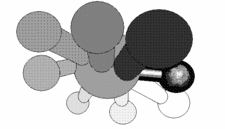
I posted the original here and on my Animation Log.
Thanks also to Three River Tech Review for linking to it.
Daniel Albright, a teacher of mine at UVa who is now at Harvard, returns often to the theme of "elementary particles" in poetry, music, and art--the charged, irreducible core memes that make art art. His writing has much to say to current digital practice, I think, where pixels, vectors, and 1s and 0s have become a philosophical as well as technological obsession. Quantum Poetics: Yeats, Pound, Eliot, and the Science of Modernism mercifully sidesteps New Age-y Tao of Physics murk in favor of single-minded focus on the wave/particle duality, dividing the poets into one or the other function. Thus, Yeats surfed The Wave with the all-encompassing poetic cosmology of A Vision, the image- and vortex-seeking Pound was a particle man, and Eliot's perverse blend of urban anomie and squishy undersea metaphors seemed All Wave until the appearance of "Christ particles" in his late work. Untwisting the Serpent: Modernism in Music, Literature, and the Other Arts begins with a consideration of the LaocoŲn problem--Lessing's formulation of the "rules" for expressing ideas in different media--and then zeroes in on peak moments in musical theatre where sounds, speech, and scenery achieve a synaesthetic unity. Albright takes most of his examples from the early 20th Century and avoids recent artforms based on newfangled gadgets, but many concerns of the Modernists--the interest in science, the exploration of psyches shaped by a technological society, the centrifugal splitting of aesthetics--have never been more relevant. (Which is not to say we have to throw out poMo critiques of those agendas.) Fair warning and/or full disclosure: In this blog and future writings I'll be leaning heavily on my old Prof's work as I stumble around trying to make sense of what's going on with new media, electronic music and tech-based gallery art.
Deborah Solomon's cutesy but miserable slam-interviews in the New York Times Magazine always take a little something out of your day. This week she talks to inept ex-CIA analyst Kenneth Pollack, who has a book out. In the runup to the Iraq debacle the debates on the liberal side came down to whether one believed former UN inspector Scott Ritter that Iraq had no WMDs, or Pollack's scare stories that Saddie the Baddie was going to nuke the Saudi oil fields and launch Armageddon. Here's Pollack now, sounding kind of flip about being so wrong (assuming it's not Solomon jiggering the quotes):
In your new book, ''The Persian Puzzle: The Conflict Between Iran and America,'' you seem to have abandoned your hawkish stance. Your last one, ''The Threatening Storm,'' helped persuade many reluctant Democratic policy makers to support the invasion of Iraq.Sorry really isn't good enough here, Ken. Instead of doing your book tour, why don't you spend some time in Iraq, say, helping medics sew kids' arms back on?
I made a mistake based on faulty intelligence. Of course, I feel guilty about it. I feel awful.
It's nice to hear at least one American say that he's sorry.
I'm sorry; I'm sorry!
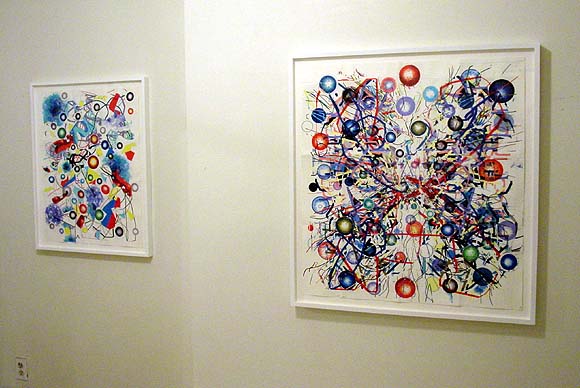
I've been doing some housekeeping around the site(s). I added an explanatory paragraph to my main site page [that para has since been moved here], largely as a reminder to curators who say things like "your blog is your art" that I'm an exhibiting artist, although it's been a long time between shows (I had a 2-person in 2002 but my last solo was '99). These gaps aren't unusual. I'm always working, but sometimes it takes a while for a body of work to congeal--by that I mean into a critically tight show. I had a five year gap between my last Texas solo and my first New York solo, and it took that long to get oriented in a new environment and not go off half-cocked. I recently discovered that Ken Johnson's New York Times review of my 1998 show (David Clarkson and I each had a room) is online in the Times archive--evidently five-paragraph articles don't require the usual obnoxious fee to view. I need to post installation shots of that show, but this picture is representative. In the comments someone asked if I'm still working large, and the answer is not that large. That show was, I would say, critically successful and led to a spate of exhibitions in the late '90s and early '00s but the work isn't collector friendly because it's huge, aggressive and made of photocopy paper (precisely the things that make it appealing to critics). I've put a lot of thought and effort into resolving this contradiction and the solution is more modest work but also more complex work, formally and thematically. I'm moving ahead with framing (see above) which is indispensable to give the current pieces a sense of solidity and presence. I think I'm giving up on the installations I was doing a couple of years back because realistically they're backbreaking (hours of standing in one position sticking pins in the wall) and I don't want the art to be about stamina. I'm kind of sick of the art world expectation that everything important has to be a physical tour de force (how much space can you fill up with some obsessive time consuming activity a la Sarah Sze, or the woman at LFL who packed the gallery with painted scrap wood). As Jon Stewart says, "I'm not going to be your monkey" even if it means perceived second-tier status. (Also assuring a lifetime of backbenching is my lack of interest in working on canvas anymore; everything I do now is on paper, which in the medieval mind of the art market means "lesser art.")
QUILT DESIGNS - FOUR SKETCHES (click images to see these samples rendered as allover patterns)
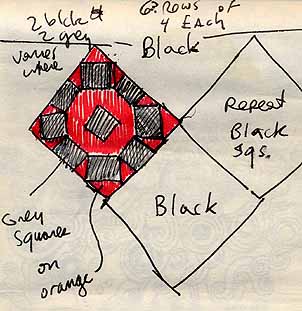
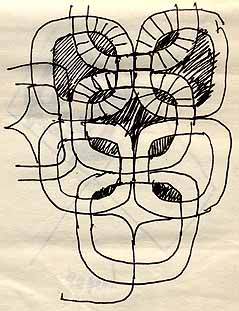
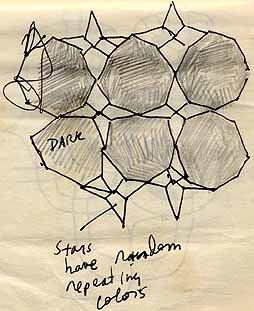
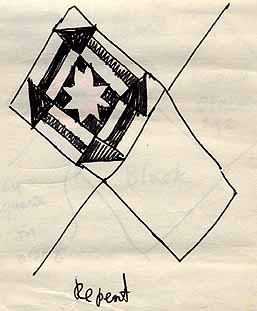
Below is an index of recent discussion topics here, which I felt like compiling because the posts are kind of spread around the blog.
What is an art blog? 1 / 2 / 3 (scroll down)
New Dumb Little Painting 1 / 2 / 3 / 4 (timeline)
Does one have to write code to make art with digital tools? 1 / 2 / 3 / 4 / 5 / 6
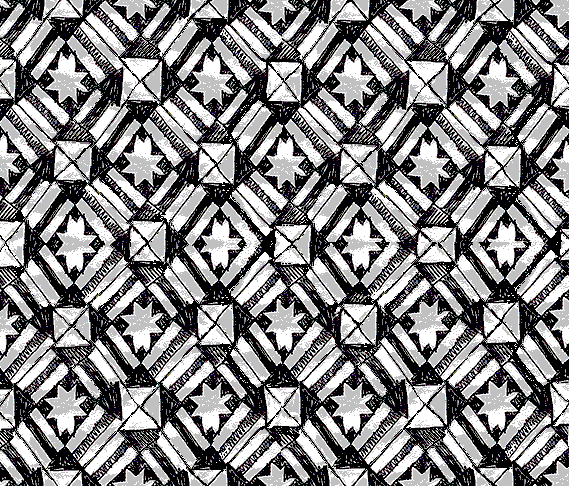
The fourth and mercifully final installment of my American Roots series--computer augmented sketches of quilts from an exhibit at the American Folk Art Museum. Think of it as the visual equivalent of "Swamp Thing" by The Grid, a somewhat awful early 90s techno track where a banjo was looped and combined with a thumping dancefloor beat.
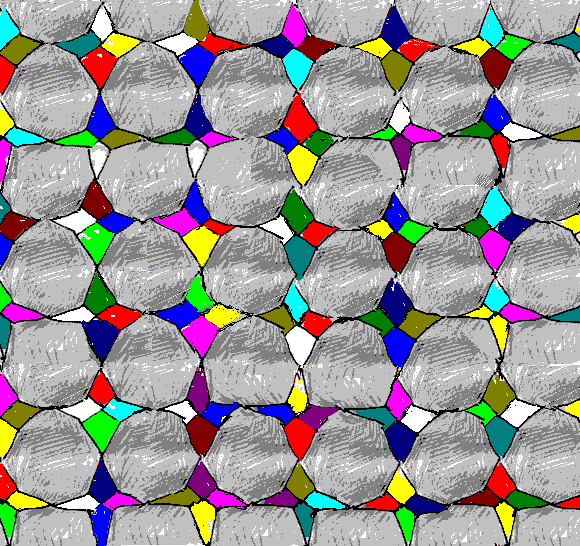
More American quilt patterning from about 80 years ago. Pardon my bad octagons.
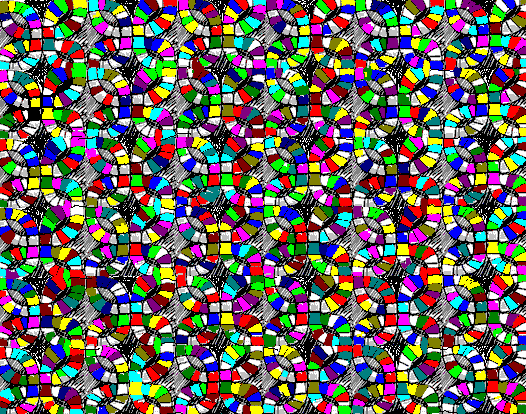
Atrios thinks William Gibson is a "techno-conservatarian," or their patron saint, and that it's somehow weirdly out of character that he'd contribute to Media Matters for America. Guess he hasn't read much Gibson--maybe he's confusing him with Jerry Pournelle?
UPDATE: Gibson replied:
The puzzling thing about this for me being: Do I have a hundred thousand politically conservative fans, and if so, *can't they read*? Most likely Atrios is referring to that sub-species of tragic mouthbreather so mesmerized by my effortless proliferation of imaginary Starck-slick gizmos that he never even notices the characterization, let alone the socio-political implications. I have always found those guys, like the ones who ask if I've read Ayn Rand, to be a distinct minority.
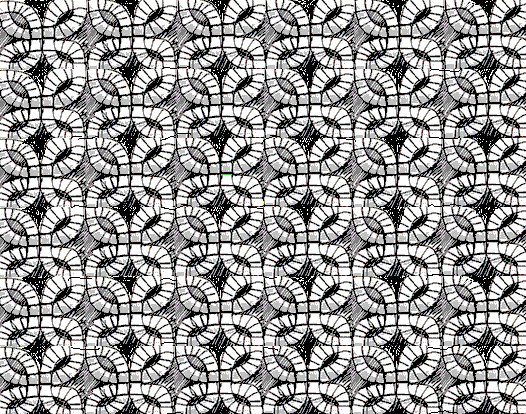
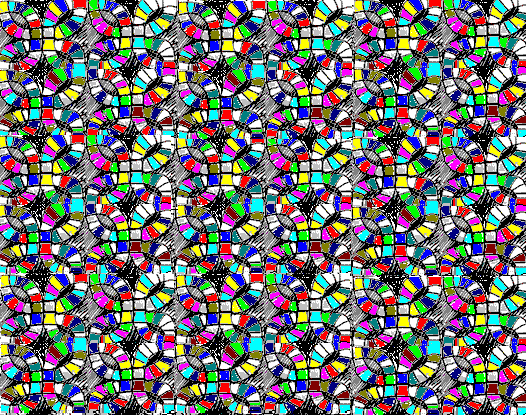
Another computer-augmented sketch of an Early 20th C. quilt design. Still working on the colors on that bottom one. In the actual quilt there was no repetition of color--the only thing unvarying was the pattern (as seen in the black and white sketch).
Amusing story in the Guardian where a reporter spent a day at the Louvre hanging out next to the Mona Lisa.
This year the crowds lining up to see it have grown thicker than ever, with the influx of millions of new Chinese tourists into Europe. A day spent in the room where the picture hangs reveals much about the global tourist industry - illustrating which countries are doing well enough economically to allow their middle classes the chance to visit France.In her quick rundown of the history of the painting, the writer gives two principal reasons for its current fame: the adoration of the romantic 19th Century poets, who were obsessed with the femme fatale, and the theft of the painting in 1911, which caused the image to be reproduced all over the world. She doesn't mention the names of those poets, but Theophile Gautier wrote that "the head makes you dream for hours" and perhaps even more well-known was Walter Pater's assessment, which Kenneth Clark called "the most famous description of a work of art in the English language":
The presence that rose thus so strangely beside the waters, is expressive of what in the ways of a thousand years man has come to desire. Hers is the head upon which all the ends of the world are come and the eyelids are a little weary. It is a beauty wrought out from the flesh, the deposit, little cell by cell, of strange thoughts and fantastic reveries and exquisite passions. Set it for a moment beside one of those white Greek goddesses or beautiful women of antiquity, and how would they be troubled by this beauty, into which the soul with all its maladies has passed? ... She is older than the rock upon which she sits; like the vampire, she has been dead many times and learned the secrets of the grave; and has been a diver in deep seas, and keeps their fallen day about her; and has trafficked for strange webs with Eastern merchants; and, as Leda, was the mother of Helen of Troy, and, as Saint Anne, the mother of Mary; all this has been to her but the sound of lyres and flutes, and lives only in the delicacy with which it has molded the changing lineaments, and tinged the eyelids and the hand (Pater, 1869).This might explain those crowds, and perhaps should have rated a mention in the Guardian article. Nowadays we would call it the power of spin.
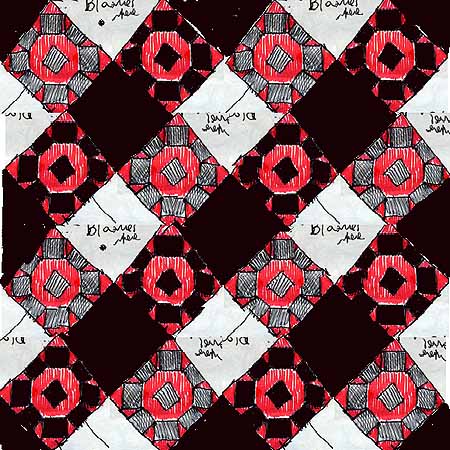
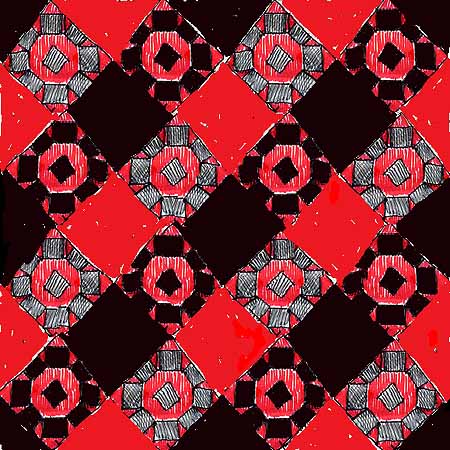
I took some notes on an early 20th C. quilt show at the American Folk Art Museum a few years ago and am just now getting around to processing them. For the above pattern, I had a sketch of one complete tile and notes on how the others went. These "computer recreations" (woo) are accurate except there were 6 rows, not four, and I believe the white diamonds (tinted red in the bottom jpeg) were black, or grey.
Tom Tomorrow thinks October Surprise the First was when Reagan cut a deal with the Iranians--"I'll give you guns if you wait till my inauguration day to release the hostages." He explains, therefore, it was kind of a "secret surprise." This is contorted. The actual history was, the October Surprise was what the Republicans feared in the 1980 election--that Carter would somehow secure hostage release right before the election. As long as we're exploding myths about the Carter era, do you think Carter wore a sweater to demonstrate energy conservation? Well, wrong! See this earlier post on the subject. It makes Republicans mad because they love their folklore as much as the Dems.
More on the increasing evidence that Pres. Bush cheats by using a wire in public appearances (including the debates): according to Dave Lindorff, who's been covering the story for Salon and Counterpunch, the Letterman Top 10 is emblematic that the media intends to treat it as a joke. The US media, that is. Lindorff says he was interviewed for an extensive story on Bush bulge that ran on international CNN but not in America.
The New York Times got criticized for calling Jacques Derrida abstruse in its obit headline, so it ran a Derrida-lovin' editorial (scroll down) by academic Mark C. Taylor as a way of making amends. Taylor declares Derrida, Wittgenstein, and Heidegger "the three most important 20th Century philosophers"--a thesis topic that reads like a TV news headline. It's like, all three must be continental philosophers, and we need one post-structuralist. So Derrida edges out Foucault and Lyotard because D. just died. The piece attempts to humanize him and make him warm and fuzzy for Times readers, talking about how important religion was to him. But Taylor's description of deconstruction mutes its dark side: as I understand it, Derrida was saying all sentences were hegemonic, i.e., territory conquering--Taylor softpedals that as "working by exclusion." Thus we don't use "grammatically correct," tightly-constructed sentences to study sentences, we play complex, punning language games that tease out their biases and inadequacies, which Derrida could apparently do well but not everyone has a gift for. The result is legions of mediocre sub-Derridas ensconced in college departments, making students hate reading. That's one reason Derrida's death is a slightly charged issue--it's not just because the neocons hate him.
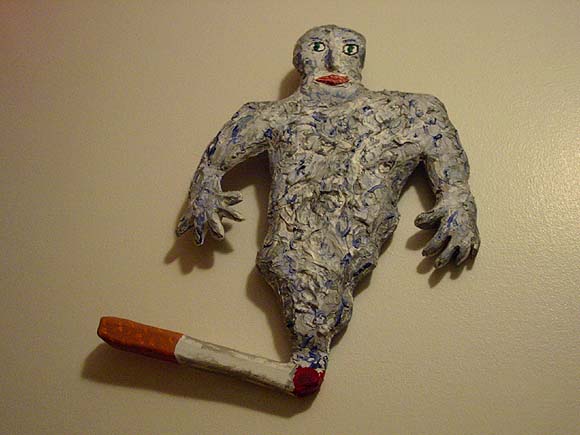
The friendly spirit who lives in a cigarette watches over my kitchen and reminds me to eat my vegetables. The sculpture is by Thor Johnson, ca. 1990.
My predecessor Eyebeam reBlogger Beverly Tang has posted photos from her summer roadtrip, from the West Coast to Tennessee and back. My favorite are her shots of skies and sunsets from the moving car, particularly on the Arizona and Texas, Oklahoma, Arkansas parts of the trip. They're crisp, striking images in terms of pure old-fashioned photographic values, but they also conjure for me the loneliness of that part of the country, where I lived and drove for years--places where some days the sky is the only thing happening (that and cafeteria shootings).
Like everyone else in the blogosphere, I enjoyed watching Jon Stewart attack the CNN Crossfire hosts on their own show (I saw the Windows Media clip via BitTorrent). The only problem is the confrontation took place on Crossfire, which means reaction shots of the guffawing audience, a pre-prepared graphic of Stewart's softball Kerry questions designed to make Stewart look weak and stupid, the emphasis on gotchas and zingers that seems to be TV's sole reason for being, and, worst of all, the presence of the two toxic hosts, doing their best to get the better of their guest. Stewart's admission that he watches their show every day considerably weakened his case in my eyes. Attacking the show on the show innately smells of co-opting--it just provides more "good television."
From today's New York Times Magazine article on the zealotry of the Bush inner circle (and true believers everywhere), written by reporter Ron Suskind (liberated version here):
In the summer of 2002, after I had written an article in Esquire that the White House didn't like about Bush's former communications director, Karen Hughes, I had a meeting with a senior adviser to Bush. He expressed the White House's displeasure, and then he told me something that at the time I didn't fully comprehend -- but which I now believe gets to the very heart of the Bush presidency.Here's hoping that come November we get to collectively say, "Yeah, well, study this, motherfucker."
The aide said that guys like me were ''in what we call the reality-based community,'' which he defined as people who ''believe that solutions emerge from your judicious study of discernible reality.'' I nodded and murmured something about enlightenment principles and empiricism. He cut me off. ''That's not the way the world really works anymore,'' he continued. ''We're an empire now, and when we act, we create our own reality. And while you're studying that reality -- judiciously, as you will -- we'll act again, creating other new realities, which you can study too, and that's how things will sort out. We're history's actors . . . and you, all of you, will be left to just study what we do.''
Tools and Media: Arcangel, Maeda, Salavon, Friedman
In the comments to a previous post, twhid made a distinction between the computer as a medium and the computer as a tool, which prompted me to discuss a work by John Maeda that I believe fails as both, as contrasted with Cory Arcangel's famous Nintendo Clouds piece, which succeeds as medium, tool, and content all rolled into one. And I also talked about Tom Friedman's and Jason Salavon's work. This post is a revised, expanded version with pictures. twhid's comment:
Perhaps people are confusing these two things: are you using the computer as a tool or as the medium?And my repl(ies):
When your friend states "the resulting visual product is what matters." This means he's using the computer as a tool to a visual end. In this sense it doesn't matter, he could be using a pencil or camera or computer or eggplants to get whatever sort of visual "product" he's after.
But if one is using a computer as the MEDIUM (not simply a means to a visual end) then it seems one should have an understanding of that medium. And it's arguable that to understand a computer as a medium you really need to be able to program it.
Then of course we can start talking about using computer networks as a medium... :-)
I've been trying to keep the discussion confined to computer-made art that winds up in the "gallery discourse," or what's left of it. The use of programming in network-based art I consider a slightly different topic. As an example of the former, what is Cory Arcangel "after" in his Nintendo Clouds piece? If it's a big Barnett Newman field he probably could use eggplants (or blue squid ink) to make it. But it's more than that--it's a work where the computer is the tool, the medium, and (at least partially) the subject matter. It works on a pure visual level (a big expanse of seductive blue with wry found imagery), as a medium (the hacked cartridge as ambient video), and has something to say to hackers and non-initiates alike about the malleability of (digital) reality, through the subtraction of information from familiar game iconography. Whether someone could arrive at something that successful without a stitch of programming knowledge is one of the questions I'm asking.
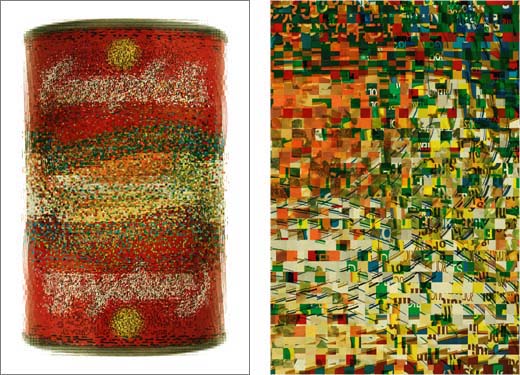
A piece that fails on all these levels is the above cibachrome print from 2002 by John Maeda, where he digitally sampled "all the Campbell's soup cans Warhol used" (as one review phrased it) and made a kind of iterative, vibrating composite. No doubt he did his own programming to realize this, but Tom Friedman, at Feature Gallery, had famously achieved a similar visual effect with a probabilistic dollar bill a couple of years before, using scissors and sheer patience. Friedman's was a well known piece in the art world, an analog design that evoked digital processes. Below is just a detail--the entire dollar is done like this, using actual cut up bucks, so the piece is about three feet long:
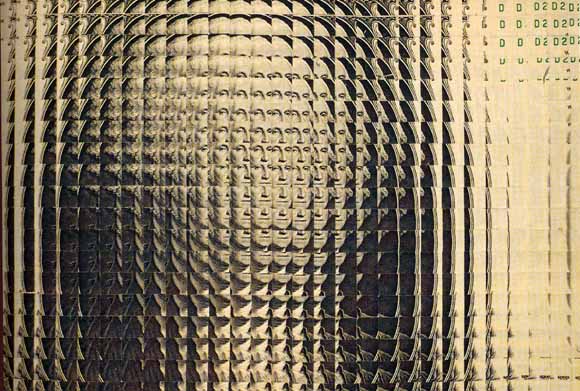
The subtle gradations between image "steps" are very trippy and disorienting, ditto seeing the familiar paper moneystuff on such a large scale. A similarly done self portrait by Friedman is online here (scroll down). As the accompanying text explains it, "Friedman dissected and re-configured 256 small, identical passport-style photographs into a large abstract self-portrait. The individual self-portraits were cut into 1/4-inch grids based on a series of nearly imperceptible 1/64-inch deviations. The 33,072 resulting squares were arranged, one by one, to create a large magnified, out-of-focus mosaic of the original image."
Maeda's soup can doesn't stretch in space but has the same hazy, micro-composite shimmer as Friedman's cut-up projects. (I don't actually consider Friedman's to be digital work, I bring it up to provide a context that previous discussion of the can has lacked.) Conceptually, and even more damning, the can is derivative of Jason Salavon, who has been making similar visual composites for years, through computer-derived averaging of like images (class pictures, Playboy Playmates, etc.) (And before Salavon, Nancy Burson...) Choosing Campbell's soup as subject matter is supposed to be "deconstructing" Warhol, one guesses, but it's a hackneyed reference. Both Salavon and Friedman know recent art history and the approximate place their work fits into it, whereas Maeda is a designer with art aspirations who admits to not following contemporary art (scroll down). Yet Maeda is showing at the London ICA and the Fondation Cartier as an artist, for reasons I don't entirely fathom (at least according to his 2002 catalog--I can't find any online reference to those shows, supposedly scheduled for 2003 and 2005, respectively).
Other Maeda work is here (I like 1, 2, and 4 but then he starts to lose me). And below is another Friedman piece that puts the can to shame. It is not out of focus; it's actual cereal boxes cut up the same way the dollar is above:
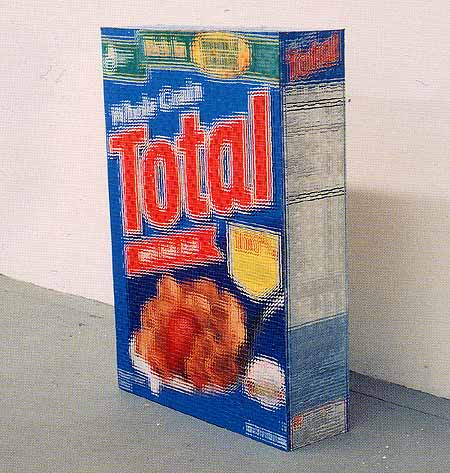
Update, December 2005: The links above to the Maeda pieces on the Cristinerose website are dead, sorry. Maeda's work did in fact get shown at the Fondation Cartier.
Update, 2011: Maeda "Food" catalog reposted as PDF
More on the Republican Spin Point Du Jour
For Pat Buchanan, the problem with "lesbian" is not that it's salacious but that it's a "cold, hard word," and Kerry's use of it is like "saying ... 'my friend's daughter had an abortion.'" What a delicate flower he is. So, it's the word, combined with people only half-following politics that think Kerry outed Mary Cheney, that's the source of the "outrage."
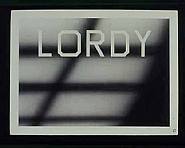
Ed Ruscha, Lordy,1991, acrylic on paper, 30 x 40.2 inches
Artist vs Programmer: How Low Can You Go?
Saying the "artist vs programmer" discussion is "stupid" (I agree, and I can only take so much of this), my friend David asks:
How low level can one go in this contest...
... did the artist develop the "language" they used to write the program to produce the art...
... did the artist write the compiler which compiles the program into machine code which runs the program which displays the art....
... did the artist build the computer which was used to write the program and run the program...
... did the artist build the components for the computer which was used to write the program to ....
... did the artist manufacture the materials used to fabricate the components used for the computer....blah, blah, blah.
IMHO, it shouldn't matter if the artist is a programmer or not, it is the resulting visual product which matters (unless the artist is into "process" art so in this case, they get all anal about the endless details of how they made such and such widget art object. But then they are really just technicians, much like print makers who only can talk about hand making their own papers from grandma's antique but stained linen bedsheets and using exotic inks made from virtually extinct sea mammals).
FWIW, many programmers feel they are artists as well. They write "elegant," sparse, and minimal code with individual "style." Their code is their art, much akin to poetry.
Pre-developed software is a tool, so are programming development languages. They both are tools which can be used as a means to do interesting things.
I try not to watch any more TV news than I have to, but I gather from the blogosphere ripples that the cable gasbags are going on about John Kerry's use of the word "lesbian." This is just rampant homophobia, and its real purpose is to deflect attention from what we all saw and heard the past couple of weeks, which was John Kerry kicking George Bush's unprepared, possibly medicated ass all over the states of Florida, Missouri, and Arizona. Said gasbags love George Bush, and they've been talking up his assured victory until it became abundantly clear to everyone in the world that when placed side by side with an actual grownup with no handlers to help him (except through that earpiece, which he used poorly) he is by far the lesser qualified candidate. How about that spit at the corner of his mouth in the third debate? And that weird phony smile? Because I haven't been cattle prodded into thinking about the latest faux controversy, those images of a bad dude in free fall are still burned into my mind.
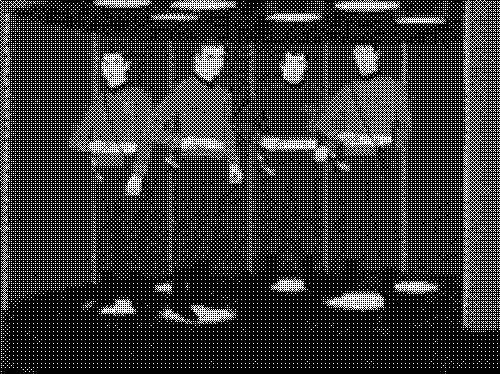
.GIF by jimpunk (from SCREENFULL - always something good going on over there).
More on the coding vs artmaking question. In the comments to an earlier post, Mark contributes these thoughts about imaging and how much can or should be left to humans:
In the process of developing video systems, I've accidentally introduced a variety of bugs that create interesting and unusual visual effects. Often an understanding how the visual and the implementation are tied together has helped me to quickly understand how to correct the implementation to make the effect go away.And my reply:
It seems that going the other way -- understanding how to modify the implementation (sw, hw, algorithms) to create effects -- would give someone more "knobs," more control, more flexibility. But of course, knowing what to do with that flexibility is all the difference.
Something I don't know how to gauge is how much power is needed. I'm amazed by what artists can do with simple tools. I think I would need MatLab to draw a decent sphere.
Some people don't think drawing contributes anything to the arena of so-called advanced art (as that concept originated in the art galleries and continues in new media) while others value it far too much--e.g. the underground economy of painting that thrives in the back rooms of even so-called conceptual galleries, based on supposed authenticity of hand skill. I think the cognitive and perceptual processes associated with drawing have some role to play as art makes its transition from the vine charcoal to the 1s and 0s phase. I really can't say what or why (not succinctly anyway) other than to say that I'm enjoying continuing to draw in a field where no one can tell whether it's computer-assisted or not. (The same comments would apply to anyone with skill on a musical instrument.)
But Mark's comment makes a pretty good case for knowing some code. The problem is up to now artists and musicians have relied on technicians to develop the "knobs," and only after a product is introduced do they get to say which knobs have the potential to expand the visual/audial landscape and which are silly, soon-to-be-dated effects. Unfortunately, to date too many of the artists who code also make crappy art--and I'm talking here mostly about stuff that finds its way into galleries, as opposed to net art that is more "about" coding. The best work is happening at the low-fi end, with the BEIGE crew, say, or the music of Paul Slocum (a post about him soon). Even in Net Art, the most interesting stuff to me is often simple html, GIFs, etc.
I was watching for signs of "the wire" in Pres. Bush's (crappy) debate performance last night. Definitely noticed he had a tendency to look down and to the right, silently, and then pop back up with a statistic or line of argument. Salon got another TV camera screen shot showing the bulge under his jacket. It appears, folks, our President is a cheater. Surprisingly, the
"Top 10 President Bush Explanations For The Bulge In His Jacket:"UPDATE: Text revised after dave reminded me that CBS isn't owned by a defense contractor. That we know of.
10. "It's connected to an earpiece so Cheney can feed me answers--crap, I wasn't supposed to say that."
9. "It's a device that shocks me every time I mispronounce a word."
8. "Just a bunch of intelligence memos I haven't gotten around to reading yet."
7. "Mmm, delicious Muenster cheese."
6. "John Kerry initially voted for the bulge in my jacket, then voted against it."
5. "I'll tell you exactly what it is--it's a clear sign this economy is moving again."
4. "Halliburton is drilling my back for oil."
3. "Oh like you've never cheated in a presidential debate."
2. "Accidentally took some of Governor Schwarzenegger's 'roids."
1. "If Kerry's gonna look like a horse, then I'm gonna look like a camel."
UPDATE 2: According to Dave Lindorff, who's been covering this story for Salon and Counterpunch, the Letterman Top 10 is emblematic that the media intends to treat this story as a joke. The US media, that is. Lindorff says he was interviewed for an extensive story on Bush bulge that ran on international CNN but not in America.
Artist and blogger twhid responds here to the previous posts (1 / 2) on whether it's necessary to know code to make digital art:
I find myself on both sides of this issue.I had hoped to make it clear that the canvas analogy isn't good, since there are decades of theory showing the canvas is a far from neutral surface and the rectangle an inherited convention that can be subverted: much modern art is about dismantling the tools of painting, conceptually, not just physically. Arguably new media art built on this existing conceptual framework of modern and poMo theory--applying its precepts to the computer, video, etc.
On one hand, I donít think itís necessary to be able to program a computer to make digital art.* Especially as the tools to create digital art get better and better. And besides, what is the difference between Windows APIs and the the interface of Photoshop? They both present you with tools to make things happen on a computer.
On the other, I think having programming knowledge is very important (but not necessary) for one to be a digital artist. I would argue that instead of Tomís analogy of a painter grinding his own paint, a better analogy is that a painter must understand how color and 2d form work. For those are the building blocks of a painting really, not the paint. Itís a mistake to confuse a computer for a canvas, to think of it simply as a means to a visual end. A computer does much more than display images on its display. With much new media art the how of image creation is just as important as the images themselves.
+++++++++++++++
*Of course you get into a whole other argument if you do agree: is writing in a scripting language programming? How low-level is the code you program? Is programming in C++ somehow Ďbetterí than programming in Java? etc, etc.
My "grinding paint" analogy was chosen precisely because it invokes the nerdy, irrelevant side of art. It's a Renaissance technology (and accompanying set of problems) that some painters unbelievably still find vital in the modern/poMo era. If knowing how to program results in some extreme refinement that Photoshop couldn't give you but is not visible to any reasonably sized art audience, then who cares about it? Those were the thoughts I had on seeing John Maeda's shows: so he can program? That means he can make more finely adjusted screen savers.
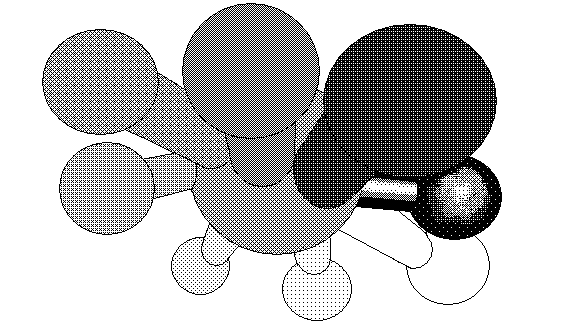
Centrifuge (Side View), Animated .GIF, 2004
Also on view in the online exhibition Sunday Afternoon, curated by MatCh-Art (Matthew Fisher and Christina Vassallo).
In the comments to my previous post about whether you have to know code to make art with digital tools, Mark says "The way I read the [BEIGE] interview, the [BEIGE'rs are] interested in programming because they are interested in complete control. Do you have to stretch your own canvas to be a painter? Well, if you're tired of rectangles, perhaps."
My reply:
That's true--but some artists were tired of rectangles and made their own, oddly shaped supports. An analogy I've used is the purist artist who thinks you have to grind your own pigment to paint, either because store bought colors aren't good enough or out of some strict truth-to-materials dictate. I think that applies to John Maeda--his "if you aren't programming you aren't using the computer" rap has a whiff of the purist ascetic about it. The BEIGE'rs are a little more complicated. They're pretty much admitting that the only way they can "own" the medium is to use old computers that they can comfortably hack, so there's a built-in humility or pathos factor there. Also, they're rejecting the store-bought colors not to show their superiority to us mortals,1 but because there's something innately offensive about always having to use Microsoft Color TubesTM (or whatever) to make art. Maeda uses his dual art & programming background as a critical shield, in effect saying to artists who don't like his work, "yes, but you know nothing about the programming" and to engineers, "yes, but you know nothing about art." With the BEIGE'rs, there's no such mystification: by using the old NIntendo games as a starting point, viewers have an accessible point of entry and can intuitively "get" what they're doing.
1. Unless you're Markus Popp.
Does one have to write code to make art or music with digital tools? Two proponents of code are designer/MIT Media Lab professor John Maeda (on the hi-fi end of the digital spectrum) and the BEIGE crew (on the low end--for a manifesto see this interview). The former may be a good programmer but he's not a particularly good artist, as anyone who saw his shows at Cristinerose Gallery will attest, whereas the BEIGE-rs are good artists arguably independent of their hacking skills. The beef about using consumer software is that an engineer makes aesthetic choices for you. But there is a whole side of digital art production devoted to thwarting the programs through non-coding means---by physical interventions like damaging CDs or analog tricks such as messing with the audio or printer output or simply using the programs "wrong"--overstressing them till they start producing intriguing gobbledegook. If you limited yourself to coding you'd miss out on other fun ways to make Photoshop and MAX-MSP break down.
UPDATE: This discussion continues in these follow-up posts: 2 / 3 / 4 / 5 / 6
.
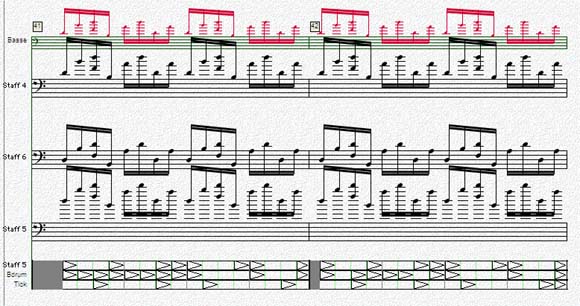
"Something Clicked" - [mp3 removed].
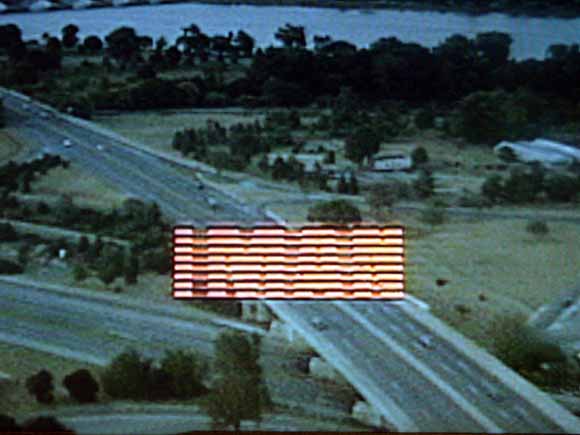
Just noticed Ted Rall's evisceration of Art Spiegelman's 9/11 book. This 20 dollar, 42-page pamphlet, padded out with thick paper stock and reprints of early 20th Century comic strips (ostensibly to show the difference between New York now and then, or whatever) sounded wretched from the reviews I read, which were mostly respectful prior to Rall's blog post. Rall, you may remember, complained loudly in a 1999 Village Voice article that Spiegelman had become a corrupt power broker of the comics world during his tenure at the New Yorker. Spiegelman left the magazine after its post-9/11 turn (further) to the right, which was laudable, even though his wife continues to hold a key position (for artists) there. The book sounded icky for framing the tragedy in terms of Spiegelman's personal meltdown and self-loathing so I didn't go near it, even to free-read it at the bookstore. Rall's take is completely vicious, but for Spiegelman to compare himself, living in a Tribeca loft after 9/11, to a German Jew staying in Berlin after Kristallnacht seems a bit...overwrought.
[The image above is not related--I put it in so the post had a 1987 reference--semi-inside joke.]
We already know that the U.S. President doesn't exactly play fair (unloading Harken Energy stock on inside information, artificially deflating the price of baseball stadium land, the 2000 election) so allegations that he has an ear-canal audioprompter telling him what to say should come as no surprise. The website Is Bush Wired? and Dave Lindorff's pieces for Salon and Counterpunch make a convincing case that not only does the little man use the prompter in speeches, but also answering tricky questions in press conferences and even to help him perform (poorly) in his first debate with John Kerry. TV stills have more than once caught the outline of a squarish lump on his back, under his suit coat, and some cable cameras have accidently picked up audio feeds from his unseen handlers. It would be great if this became a campaign issue but it's doubtful given how much the press loves him. If he gets a second term (no! no!) we will somehow have to come to terms with the fact that he's our first Bionic President.
UPDATE: Unbelievably, the New York Times covers this (" The Mystery of the Bulge in the Jacket"). I guess once Salon was on board, it became OK. And the reporter is Elizabeth Bumiller, who generally writes love letters to Bush.
UPDATE 2: Dave says George Stephanopolous mentioned it on the Sunday talk shows but just treated it as a joke. As the Daily Howler would say, "once again your media is clowning."
UPDATE 3: This Bush interpreter has heard the President speak perfectly without notes on subjects of great complexity, leading the interpreter to believe he's wired. But what works in a speech context could be a liability in the debate context--listening to two people at once is hard.
From E. Worthy, Early 21st Century Art (New York: Kramer Publishing 2035):
"The death of so-called site specific art came in 2004, at a talked-about show most people never saw. The concept was that artists would 'respond' to Eero Saarinen's somewhat overwhelming 1962 terminal building at Kennedy Airport (considered high Modernist kitsch by some architects), an activity with roughly the same significance as small lice-eating birds 'responding' to a rhinoceros. It consisted of such obvious and expected gestures as running political slogans on the defunct terminal's arrivals and departures board, piping sound art through the intercom, and so forth. Once admitted to this vast playground from their usual physically constraining warrens in Chelsea and Williamsburg, and perhaps because the art was so familiar as not to hold anyone's attention, the artists went berserk at an opening night party and trashed the terminal."New York Times report
Installation shots of a Vanity Fair party two nights before "amok night"--thanks to Bill for the pics and timeline
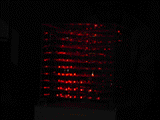 Last night at Dorkbot NY, the informal monthly gathering subtitled "People Doing Strange Things with Electricity," three people gave presentations. Left is my accidental .GIF (I thought I was making an MPEG movie) of James Clar's 3D Display Cube, a device that uses a hideous amount of computing power to render charmingly lowtech 3-D moving sculptures on 1000 LED lights in a 2 foot cube. Think 3D Jim Campbell. Mary Flanagan projected complex abstract patterns generated from the phonemes and word choices of a several month run of
emails between her collaborator Andrew Gerngross and his ex-girlfriend. It was unclear whether the, um, relationship between the data and the display was purely aesthetic, or if there were other connections or conclusions to be drawn. Fang-Yu (Frank) Lin gave a crisp power point talk on "channeling the internet though a robotic typewriter." His artwork was exactly as described: a clunky hybrid of an old manual keyboard and a teletype machine, which acts a kind of spirit medium, bringing you messages from "the internet," a quasi-mystical entity. You type in a question or statement, and hidden hardware and software search for words (in chatboards, blogs, news stories) that might logically or literally follow from what you wrote. Of course, the result--lines of text or ASCII pictures spit out of the teletype--are usually tangential (at best) to your request. Lin uses a hybrid search engine to pull up content, but casts a narrow net, apparently grabbing the first thing remotely connected to your search. The piece was almost aggressively dumb, and retro, and pseudoscientific, a kind of satirical antidote to the globalist, futurist slogans routinely bandied about by tech companies and new media visionaries (cf. Maciej Wisniewski's netomat). I immediately thought of Scott Bukatman's essay "Gibson's Typewriter," which considers the global information sea change through the metaphor of William Gibson banging out Neuromancer on a manual typewriter. Lin's presentation echoed one of Bukatman's themes--that mechanical writing was an earlier and no less earth-shaking "information revolution." The fixation on the typewriter is also in sync with current trends such as whipping out giant old cell phones purchased on Ebay to impress potential dates.
Last night at Dorkbot NY, the informal monthly gathering subtitled "People Doing Strange Things with Electricity," three people gave presentations. Left is my accidental .GIF (I thought I was making an MPEG movie) of James Clar's 3D Display Cube, a device that uses a hideous amount of computing power to render charmingly lowtech 3-D moving sculptures on 1000 LED lights in a 2 foot cube. Think 3D Jim Campbell. Mary Flanagan projected complex abstract patterns generated from the phonemes and word choices of a several month run of
emails between her collaborator Andrew Gerngross and his ex-girlfriend. It was unclear whether the, um, relationship between the data and the display was purely aesthetic, or if there were other connections or conclusions to be drawn. Fang-Yu (Frank) Lin gave a crisp power point talk on "channeling the internet though a robotic typewriter." His artwork was exactly as described: a clunky hybrid of an old manual keyboard and a teletype machine, which acts a kind of spirit medium, bringing you messages from "the internet," a quasi-mystical entity. You type in a question or statement, and hidden hardware and software search for words (in chatboards, blogs, news stories) that might logically or literally follow from what you wrote. Of course, the result--lines of text or ASCII pictures spit out of the teletype--are usually tangential (at best) to your request. Lin uses a hybrid search engine to pull up content, but casts a narrow net, apparently grabbing the first thing remotely connected to your search. The piece was almost aggressively dumb, and retro, and pseudoscientific, a kind of satirical antidote to the globalist, futurist slogans routinely bandied about by tech companies and new media visionaries (cf. Maciej Wisniewski's netomat). I immediately thought of Scott Bukatman's essay "Gibson's Typewriter," which considers the global information sea change through the metaphor of William Gibson banging out Neuromancer on a manual typewriter. Lin's presentation echoed one of Bukatman's themes--that mechanical writing was an earlier and no less earth-shaking "information revolution." The fixation on the typewriter is also in sync with current trends such as whipping out giant old cell phones purchased on Ebay to impress potential dates. "The bankroll [for Gold Diggers of 1937] went to the one big Berkeley number at the end--'All Is Fair In Love and War.' It's a simple piece, lines of chorus girls dressed in white against a shiny black floor, but it is simply astonishing (the song is pretty catchy too)." I agree with the IMDb commenter--that the musical number is astonishing. A stop motion Magrittean exploding chair turns into a cannon; the cannon shoots white balls at the viewer that dissolve into chorus girls' faces; giant flags make twin inverted intersecting corkscrews--my jaw bobbled watching the intricate geometries of film genius Busby Berkeley on Turner Classic Movies just now.
Last night's debate goes to Edwards for staying on message and all-round joi de vivre, even though his message on Iraq is some scary BS. Cheney looked haggard, and by not responding to the frequent charges of corruption, incompetence, and lying it looked like he didn't care, either out of arrogance or just weariness. In the debates so far, both Edwards and Kerry have been like the savior one rarely gets who steps in to tell an alcoholic parent, spouse, or boss that "no, in fact you're wrong, and you can't just give people that evil look and get your way." A real drink of clean water after almost four years of arsenic-tinged sludge.
an interview with jenghizkhan
[This interview has its own page here. I'm posting it in full on the blog, as well. --TM]
I first heard the music of jenghizkhan (aka John Parker) at the Brooklyn space vertexList, and described it enthusiastically here as "mysterious, sexily-filtered ambient industrial keyboards."* Later I heard him perform with Man from Planet Risk, his duo with Cave Precise (Ron Ramey), both in a live club setting and on CD. In a post on the band I commented on the differences between their live and studio sounds:
For all its echo-y horror soundtrack atmospherics and Black Sab-like bass riffs, the CD is much lighter [than the live playing]: the beats are spryer, with turntable twists & jazzy piano riffs livening up the doom and gloom. "Triphop" comes to mind because the sound is truly trippy: jenghizkhan approaches music like a painter (and is in fact a visual artist, exhibiting under his non-nom de plume), taking advantage of all the filtering and timestretching capabilities of modern keyboard tech to make layers of artfully mangled sound. Imagine Ennio Morricone eclectism shot through with the kind of dreamy, smeared psychedelia of San Francisco post-punkers Chrome, or the European hardcore tech of The Mover set to a hiphop beat.
Since then, I've listened to jenghizkhan's solo CDs Hooden Knooks and Brooklyn Sucks. It's great stuff, what the late lamented Throb records would file under "braindance" and what I would call "art electro." By way of comparison, I went back and gave another spin to the Ischemic Folks compilation, which many considered a watershed for this kind of intensely digital electronic music, and have to say I prefer jenghizkhan's improvisational style with the laptop. Except for a couple of lush Richard Devine compositions, the IF CD is brittle and analytical, with too much of the Miami Bass parent DNA decanted out in the name of art.
Mixed in with jenghizkhan's trademark doomcore riffs one hears a lot of humor, and a strong melodic sense even when he's furthest out there in the drill-and-bass, sound-bending zone. As audio abstraction it's more frenetic de Kooning than faux-febrile Richter, and for all his insistence on "modern digital synthesis" over retro styles and sampling (see below), his compositions have the verve and warm texture of early analog and tape recorder music (e.g., Mario Davidovsky, Otto Luening, Richard Maxfield), as opposed to the rather cool "glitch" sound of Oval, Phoenicia, et al. Check out these tracks from the CDs: "Sidewinder Circus" [spotify], where the digitally scrambled phrase "sidewinder heat-seeking missile" sniggles in and out of overdriven-soundcard-like raunch, and "Outlet Nightjar" [ 3.56 MB .mp3], in which a synthetic bowed string keeps sounding the same ridiculous note in counterpoint to a heavily reverbed pseudo-guitar.
The following interview was cobbled together from emails I exchanged with jenghizkhan after we visited each other's studios. We're both visual artists involved with music (although his creative audio output far exceeds mine) and some running themes of our (still ongoing) discussion are sampling vs synthesis, painting vs musicmaking, and why the digital production of music so far has outstripped digital imaging as a creative medium. Mostly though, we talked about the really important stuff: gear!
Tom: Let's talk about Man from Planet Risk. As I mentioned, the live sound differs quite a bit from the studio recording: the beatbox-style beats on the CD sound very hiphop but with Cave drumming live the music has more of a heavy metal feel. You told me that the two of you have rather different philosophies; that Cave likes live playing and working with samples of live playing, while you favor synthesis and software laptoppery. What directions are you two coming from? What are your influences?
jenghizkhan: Actually the CD is composed of real time playing that is sometimes looped; both of us play in real time. You may be able to hear it in our CD in that it is not so perfect or too mechanical.
As for influences, I would say that Cave has been schooled in hip hop but is fascinated by classic metal. He tends to stay in the middle of the road when it comes to his likes but with a very deep understanding of how music is crafted.
I don't have enough perspective on myself to make a similar sweeping appraisal, but if I had to throw some influences out there, they would be: old Tricky, old Cure, experimental Scanner stuff, and Kurt Cobain songwriting. Although I named mostly mainstream influences, I tend towards unusual stuff liking parts of songs rather than a particular artist.
We meet somewhere between those two tendencies. We are very facile at making music and try to keep it from turning out cliche. The last track on our E.P. [.mp3] was a deliberate attempt to not lose some hiphop fans and is probably the most mainstream track and not a future direction. The first track [.mp3] represents how we work now, and it is not that popular.
T: When I came to your studio you walked me through some of the programs you use; thanks for that, it actually helps when I'm listening. I'm impressed by the full, rich sounds you're getting from the laptop. And you have a great ear for psychedelic "texture." I do hear some Morricone influence--not that it's derivative. Do you listen to him at all?
j: I did listen to Morricone in the mid-80's, among other things. I also studied Classical music for a semester at Princeton. Besides learning the piano when I was young (which I can no longer play) that may be the training that is emerging through the mix.
T: Did you ever get the SidStation synth we talked about?
j: I did--I like it but will probably sell it in a few months. Do you want it? It's expensive but will only increase its value since it was such a short run and the original Commodore SID chips are hard to come by. [The SID6581, a chip combining digital and analogue technology, was a part of the Commodore 64 computer, an '80s-vintage machine much loved by hackers; according to the manufacturer, its programming is "based on over 10 years of experience from the C64 hacker community." --TM] I thought you might be interested since it is so low-fi digital. Whole songs can be written on it.
T: Short answer--yes! What did you not like about it?
j: I like it OK but the Monomachine has a SID emulator that I like just as much. Also, this machine really needs to be with someone that loves it. It definitely has that 80's video game appeal. What's supposed to make this better than other SID machines is the programming that went into it. I don't really know that much about the programming but can tell from their later machines that it must be brilliant. There were a little over 1000 SidStations made.
I had the same issue with my Virus which I sold to Cave. He loves it; I just know it as one of the best synths ever made. The other factor is that I have come to a conclusion concerning my focus with sound. I really like modern digital synthesis. I want to explore the possibility for new sound with the Monomachine and Native Instruments' REAKTOR software. I'm selling the rest.
T: I figured it might be because of the retro thing. That concerns me too. I'd like to try to make something with it that sounds good but doesn't immediately scream video game or 80s. That may be impossible, but I like the aesthetics of the machine based on what I saw and heard on the website.
It's funny, what you're saying about using the most current digital tools resonates for me when I think about music (mainly as a listener), but I don't feel that sense of purposeful excitement with the tools on the visual side. Maybe I'm just not seeing someone really screwing with state of the art software so it doesn't look so much like...state of the art software. I admired the Jeremy Bernstein video that came before you at vertexList that night but I didn't love it. I could see it was cutting edge animation but felt no urge to go there myself.
j: I agree about the prevalent visual digital conservatism. It seems as if everyone is using visual digital tools for convenience (meaning everyone is doing the same old thing but more facilely). In fact, I am left admiring hackers for anything non-aural. Interestingly, the designers of the SidStation were hackers.
The stuff I find in sound is ugly and dumb. I think perhaps that might be a clue as to what to do visually. That's why I like the stuff you are on to.
The SidStation definitely can make some great sounds if you are exploring the way in which you seem to be interested. I'm not going to get that deep into it. I do want to check out the modulation sequencer -- I'll probably do that in a couple weeks. It is not retro; it just uses an under-appreciated sound generator.
You will probably want to control it via your computer. In fact (+ perfectly) you will be able to use that program that you showed me [Harmony Assistant --TM.] to write notes that play the SidStation. You should check out if your program sends midi.
T: It does--I just have to get it set up (uggh). Speaking of which, and changing the subject to your solo CDs, isn't that the SidStation on "Jenghiz, the Damager"? It's very catchy [spotify]. There's a lot of humor in the music, even when it's dark and doom-y. "Outlet Nightjar" also cracks me up.
j: I actually used my circuit bent Casio SK-1 on "J, the Damager" but you are right it is practically the same thing. The SidStation has more sound options and control but you have to write the music. The Casio just spits out stuff. (In fact it may be catchy because the Casio plays "bent" versions of original presets. You may have heard something vaguely familiar 20 years ago.)
T: There was some other software you showed me in your studio, besides REAKTOR, to make your music. Do you remember what it was?
j: I'm not sure which programs I showed you. REAKTOR is a fully modular software program that does analogue modeling and digital synthesis as well as having a wide range of sequencer capabilities. It's similar to MAX-MSP, which is even more flexible and has more possibilities. I like REAKTOR because it has an online library with contributions from REAKTOR users all over the world and because it tries to emulate synthesizers of the past. Then I just start rearranging the virtual wires until it is screwed up and sounds new to me. I like working in the direction of making something "wrong" rather than the one of making something "right."
I do the same thing with the Monomachine (and, on the Brooklyn Sucks CD, the Korg Electribe ES-1 and EA-1). The circuit bent Casio SK-1 is already wacko. I started making music by scratching CD's that I made from digital noise samples (similar to modem tones). I got the samples from saving the screwed up files that my computer sequencer would spew out when it crashed (which was all the time in the beginning). Ironically all this happened in my attempt to make "real" music. One scratched riff is the main melody in "Killing the Messenger," the first song on the Man From Planet Risk CD.
Other programs are Emagic Logic and Ableton Live, which I use in a traditional studio way to put my ideas together.
T: I'm pretty sure the two programs you showed me were Logic and REAKTOR. I like what you're saying about "rearranging the virtual wires" in REAKTOR. When you say "The circuit bent Casio SK-1 is already wacko," is "circuit bent" your term? By wacko, do you mean you did something to it that can't be reversed? Are you talking about MIDI controlling a physical Casio or a playing a virtual Casio within REAKTOR? Also, just for clarification, you said "I started making music by scratching CD's that I made from digital noise samples (similar to modem tones)." Do you mean physically scratching, as in damaging, the CD, or scratching as in "Do You Like Scr-Scr-Scr-Scratchin'"?
j: In general, I am not a fan of midi. A lot of new electronic music is made that highlights the capacity of midi. I just use it to do very basic communication between machines like notes and time clock. As with the Man From Planet Risk CD, all my CD's are composed of real time playing (sometimes looped).
For the Korg I loaded in digital sounds that I then made into kick drum like sounds, etc. or left them raw. I played it like an instrument, recorded some phrases and then looped them in Logic. At the time I was timid so I often took a wild sound and tamed it into a more familiar one. My new work will be left untamed.
Circuit bent is a relatively new term to describe instruments that have had their internal wires re-arranged from their original purpose in order to maximize their sound-making capabilities and experimental possibilities. (Sort of a real world version of REAKTOR). I played the SK-1 as an instrument and then recorded it and looped it in Logic. In fact, "Jenghiz the Damager" is pretty much one live take with one part edited out. I practiced it 20 or so times and then recorded it. The problem, or genius, with circuit bent machines is that they rarely do the same thing twice. Here is the link to the builder, Arius Blaze. I think you may find this and his links very interesting. He belongs to a very passionate music culture. They convened in New York this summer for the very first time to exchange ideas.
And I mean Scr-Scr-Scr-Scratchin but sometimes at a super subtle and slow rate so that I can draw out all the tones that make up the white noise of digital streaming information.
I don't use Logic in a very experimental way. I do use it to do some granular resynthesis with Pluggo plug-ins (made in MAX-MSP). Otherwise, I just throw loops into it, make arrangements, mix and master. I may have shown you Ableton Live which I will use in the future because it provides more possibilities to play with arrangements.
T: This whole business of moving sound around among instruments and software makes locating the "real" source of the music pretty daunting, conceptually, though I don't know why I should still find that important. With a guitar, say, you always intuitively know what's making the sound and where it's coming from. Also, I have a hard time keeping straight what are inherently analog or inherently digital properties.
I did know about the circuit bending, homemade instruments phenomenon, just not by that term. Peter B, Paul Slocum, Nautical Almanac are three artists that come to mind--a couple were in that Bent festival (which I unfortunately missed).
j: All my instruments are like playing the guitar including REAKTOR on the computer. My schtick is playing the computer like an instrument. Then I use Logic to put all the recorded sounds of various instruments together and make songs. Sometimes I add additional virtual instruments within the program.
Midi is just a language for machines to talk to each other. Midi makes no sound. That is often the source of confusion. I do not explore the possibilities of midi. I find it dehumanizing even though it is very popular these days: all those rapid changes, extreme effects, movements that a hand strumming strings on a guitar could never make.
I joke with Cave that the guitar is a dumb instrument. What makes the guitar interesting is how much you can get out of its limitations. I enjoy the wider range of possibility that synthesis involves.
Analog has to do with electric currents and voltages. Digital has to do with 1's and 0's (i.e. granular resynthesis is chopping a sound into tiny bits and moving them around at different speeds.) It's difficult to make digital synthesis sound alive like electric currents although I like the challenge.
In your situation you can use your computer as both a tone generator (the inherent digital sounds that it possesses) and a sequencer that plays both the sounds in the computer and the sounds in the SidStation via midi. You would work the same way as you have but just have the added richness of a professional tone generator that has buttons and dials.
T: I want to come back to the issue of sampling vs synthesis, which we were discussing in connection with Man From Planet Risk. You sent out an email recently for a gig and made a kind of "no samples" guarantee. What's up with that?
j: In my email I said something along the lines of, "I'll be performing live digital synthesis -- that means no wimpy samples!"
This is actually a reference to a way of playing live rather than a general argument for synthesis vs. sampling. I often find live electronic acts tedious because they basically play a tape of what they've created in the studio. Hiphop has been a culprit of this whereby the music is played from a DAT tape with a DJ adding some vinyl scratching or flourishes over the top of the mix. The main live element ends up being the rapper, and I personally have always preferred music to lyrics. Hiphop has come to grips with this limitation. Now hiphop acts (like Outkast) have live players that actually play the drums, guitar, bass, and keyboard or send out samples on the fly from a machine or vinyl. I find the tension of the players on stage having to pull off a song together much more interesting than a guy doing Karaoke to tape.
There is a difference between live DJ-ing and live synthesis. A live DJ makes choices from already complete excerpts of music that can stand on their own. A DJ's creative input is in his or her choice. With live synthesis you begin with a blank slate excerpt for some parameter settings or a saved phrase of notes. You never know where your journey of knob twiddling will lead you -- good or bad.
Recently the lines between synthesis and sampling have blurred because sample libraries have become so vast that they include every minute detail of any instrument. So every possible sound of a synthesizer can be sampled. Hence they are the same, in theory. However, there is a crucial difference:
The difference can be described by a painting term--"plasticity." A sample can only be pulled and prodded to a certain degree. Eventually when it has been modified by effects it will sound just like anything that has a heavy dose of that effect. You can no longer hear the original sample. Synthesis is much more "plastic." You are working at a more essential level either manipulating electric currents or their mathematical equivalents. There are so many more possibilities and so many more directions in which to go. This can lead to some really bad results which is actually hard to do with sampling (and perhaps why it is more popular). (De Kooning once said when visiting a colleague's studio that he had no bad work around. That was how he knew that he was not making anything interesting). I prefer the possibility of synthesis over the control of sampling.
Cave and I do not exclusively sample or synthesize. Both are essential parts of making electronic music. At some point in most cases I have to sample any synthesized phrase that I make so I can arrange it to make a song. The only difference between the way we work is Cave often samples a phrase from old material that he believes has been overlooked or would sound interesting in a new context. I usually make my samples from scratch. The tension between the two is why I believe we are on to something really interesting in Man From Planet Risk.
*FOOTNOTE: He has since posted those performances on Soundcloud, captioned "live digital synthesis with the Elektron Monomachine." The track "4scratch" is one of my favorites, and I did a remix, consisting solely of lopping off the intro and cutting straight to the monster, four-note hook that first grabbed my attention: [4.7 MB .mp3].
equipment list:
jenghizkhan (current solo and Man From Planet Risk): G4 laptop; sequencer: Emagic Logic and Ableton Live; softsynths: REAKTOR, Crystal; effects: Pluggo and Ohmforce plugins; Elektron Monomachine, Machinedrum, and SidStation; Circuit Bent Casio SK-1 by Arius Blaze; Elektrix, Akai, Mutronic's Mutator and Sherman Filters; Zvex Machine Distortion Pedal; Red Sound XS-FX effect processor; Dave Smith Evolver and Roger Linn Adrenalinn; Clavia Nord Modular
Cave Precise's equipment for MFPR: E-mu SP 1200, Ensoniq ASR-10, Live Drums, Live Bass, Roland Juno 106, Novation Superbasstation, Access Virus C, ProTools LE, Akai MPC2000XL
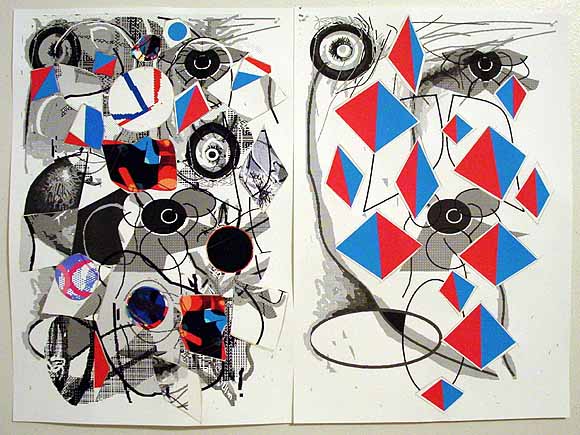
"Synthetic Synthetic Cubism"? Yeah, it's a misnomer--Synthetic Cubism was essentially late, illustrational Cubism but this current work I'm doing has more in common with the early, incomprehensible Analytical phase. The director of a nonprofit gallery that only shows overtly political work visited the studio a couple of years ago and dismissed pieces of this ilk as "just Kandinsky" (also not a Synthetic Cubist, but close enough). I take that as a compliment, since last I heard Mr. K. worked with paint (with all its history and baggage) and these are entirely done with a computer, printer, scissors, and tape. Masquerading as somewhat stylish drawings and paintings, they are simulacra--"robot Kandinsky." Unlike Mike Bidlo and the appropriators, though, I'm not making facsimiles of known early Modernist works. I'm actually still interested in the puzzles of representing a "vortex" or "field." How much does that "pure" field reflect the stamp of the imaging program? Can that programming be circumvented or thwarted? What is inherently "cyber" and what belongs to the pre-technological past? Those are some of the issues here.
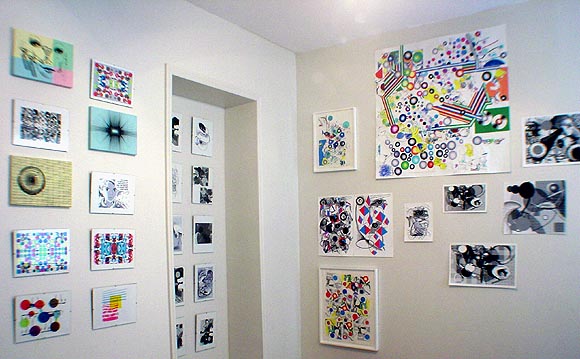
Very funny/creepy montage here (Quicktime movie), consisting of fast clips of the fear buzzwords used over and over by Republican National Convention speakers. See McCain, Bush, Cheney, Pataki, et al saying "September 11," "Global Terror," "Saddam Hussein," "Weapons of Mass Destruction," etc. without the intermediate filler of their speeches, until you're ready to scream. The rhythms of the editing of the clips are very cleverly done. I missed the convention on TV, so it was good to get it in capsule form like this. Biggest ass of the lot: Rudolph Giuliani. (I expect this'll be all over the Net soon, if it isn't already.)
Debate 1 Recap: Kerry beat Bush on facts. But Bush, being a religious fanatic, stays on message, even though he f-ed up in Iraq. Kerry has no good answer to Bush's oft repeated criticism: How can you say "wrong place, wrong time, wrong war" (that is, make a devastating and accurate critique of prewar machinations) and expect to win the war? How does that inspire the troops? Kerry says he'll "win" by (1) going to the UN, (2) getting more allies involved, (3) strengthening Iraq's borders, (4) giving our troops body armor, (5) "chang[ing] the dynamics of the ground" (i.e., flattening Fallujah), while all the while criticizing the Administration's plan to build 14 military bases in Iraq. That is indeed a contradictory mix of signals. And would France or Germany really commit troops at this point? No. Will Arab nations? Get real. Bush plans to pour it on and kill more people without help; Kerry plans to bring in allies to help us do it, which will never happen. Kerry wants us to stay in Iraq for the usual bleeding heart "humanitarian" reasons (killing rebels for peace); Bush wants to do it to show Americans are tough (and for the oil). Yet I think Democrat and Republican voters alike are secretly banking that both are lying and will do a quick pull-out after the election. Both positions are phony, but Bush is at least internally consistently phony.
UPDATE: From the lead paragraph in the NY Times coverage today: "And it was body language as much as rhetoric and one-liners that distinguished the two candidates in last night's debate. " There they go again, focusing on the cosmetic stuff, avoiding discussion of the issues. "We'll get allies involved." Rii--i-ight.
entelechy
Function: noun
Inflected Form(s): plural -chies
Etymology: Late Latin entelechia, from Greek entelecheia
1 : the actualization of form-giving cause as contrasted with potential existence
2 : a hypothetical agency not demonstrable by scientific methods that in some vitalist doctrines is considered an inherent regulating and directing force in the development and functioning of an organism
funkentelechy
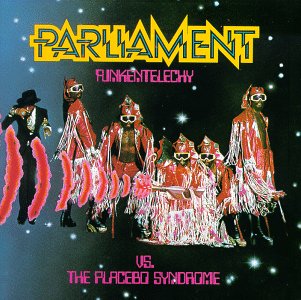
Debate questions from today's New York Times op-ed page, annotated.
WHAT TO ASK JOHN KERRY (note the Times puts the conservative questions first)Better questions, please?
WILLIAM KRISTOL: If you now consider the war in Iraq to have been a mistake, how could you, as president, "ask a man to be the last man to die for a mistake"? (Translation: Kristol wants men to die.)
RUTH WEDGWOOD: How could we have guarded against Saddam Hussein's reckless nuclear intentions? (Assumes Saddam was a threat, recently disproven.)
VICTOR DAVIS HANSON: What precise plans do you have to induce positive changes in attitude in Iran, Lebanon and Syria? (Assumes we're the "world's cop.")
WHAT TO ASK GEORGE BUSH
MADELEINE K. ALBRIGHT: Since our direction in Iraq is obviously wrong, don't we at least need to change drivers? (Editorial masquerading as a question.)
RICHARD A. CLARKE: Under what circumstances would you authorize military action, including an invasion, to achieve regime change in Iran? (Assumes we're the world's cop.)
ARTHUR M. SCHLESINGER Jr.: What is the relation between your Christianity and that preached by the pope and by mainstream Protestants who oppose preventive war? (Philosophical question no one in the public expects a politician to answer.)
